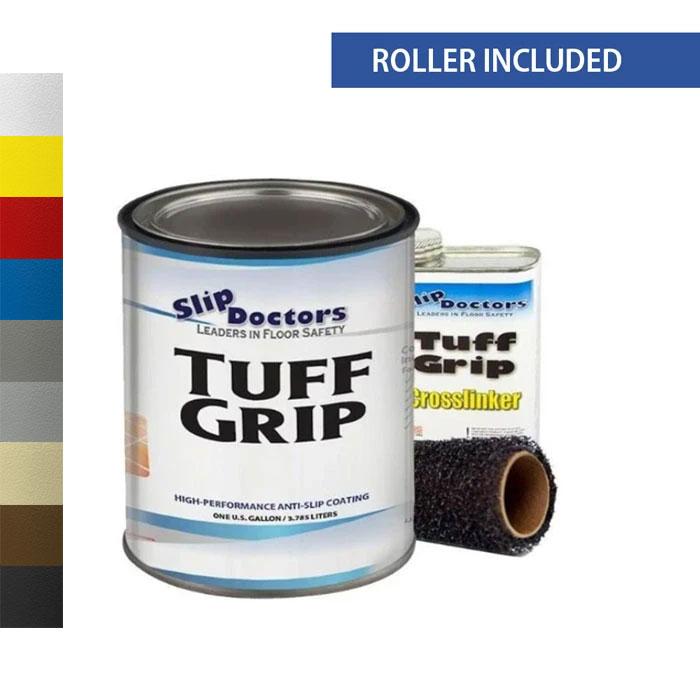Customized Stop-the-Slip Solutions
For Your Unique Conditions
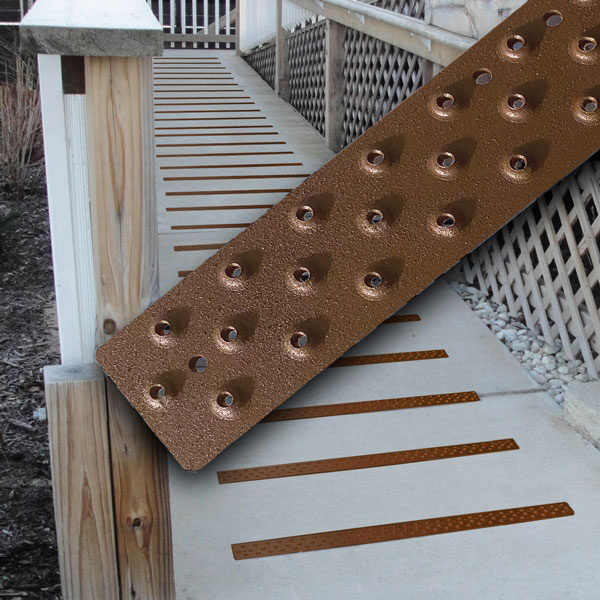
If you have a long wooden ramp at your home or office, you probably know that even the smallest incline can encourage slips, trips and falls. The fear of slipping when walking up a ramp, or even helping a loved one in a wheelchair can motivate you to find a solution.
The Animal Welfare Society of Monroe County in Pennsylvania had long wooden ramps that were slippery for pets and people alike. Here’s how they solved their slippery ramp problem.
Your Stop-the-Slip Solutions Graded:
Deck Treads: A-
HandiTreads 48″ aluminum aluminum Deck Treads are designed to be used on large areas of wood decking. At 1.875″ in width and 48″ in length, the cover more ground than our stair treads and, to be honest, fit in visually much better on most expansive deck and patio surfaces. We never thought of using them on wooden ramps – until our customers starting sending us photos of them used on ramps!
What makes the HandiTread Deck Treads especially well suited for long ramps is that they can be placed on every other board on the ramp providing sure footing and great looks at an affordable investment.
Because ramps are inclined, they encourage slips and falls. When you add external conditions like rain, algae or snow to a ramp, the slip and fall hazard increases dramatically.
Like all of our aluminum treads, the pressure from a step on the raised traction buttons pushes away the layer of moss, mold, moisture, frost or up to an inch of snow, creating solid contact between the tread and sneaker, shoe or boot.
Installation of the aluminum deck treads is very easy requiring only a driver drill, measuring tape and pencil. Unlike grit paint, there’s no need for time-consuming and messy surface preparation. Once installed, no maintenance is required for Deck Treads which are guaranteed to last a lifetime in residential applications.
If you live in an area where it snows, you can use a snow shovel on your HandiTread Deck Treads without damaging them. Do this to grit tape or grit paint and they’ll pull right up
Because HandiTreads Deck Treads are a forever solution, the long term value is exceptional!
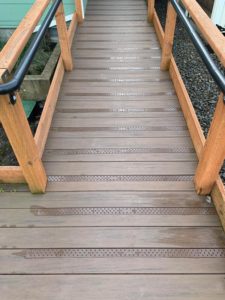


Total Score: A-
Effectiveness: A
Installation & Maintenance: A
Durability: A
Initial Price: B
Long-Term Value: A
Handi-Treads: B+
Handi-Treads aluminum treads are the most effective, long-lasting solution for minimizing the risk of slips and falls on wooden ramps that are often used for wheelchair access. Because ramps are inclined, they encourage slips and falls. When you add external conditions like rain, algae or snow to a ramp, the slip and fall hazard increases dramatically.
Handi-Treads work very well on long residential and commercial ramps because they provide exceptional grip under the most challenging conditions. The pressure from a foot stepping on the raised traction buttons pushes away the layer of moss, mold, moisture, frost or up to an inch of snow, creating solid contact between the tread and sneaker, shoe or boot.
Installation of the aluminum Handi-Treads is simple, as you can see in these installation instructions. Unlike grit paint, there’s no need for time-consuming and messy surface preparation. Once installed, no maintenance is required for Handi-Treads which are guaranteed to last a lifetime in residential applications.
If you live in an area where it snows, you can use a snow shovel on your Handi-Treads without fear of damage to the treads. This is not the case with most other solutions.
The initial cost to fit a 10-foot or longer ramp with Handi-Treads can be substantial, depending upon your budget. We recommend spacing the treads at eight inches apart, or every other board. We recommend using 8-inch spacing between treads on most ramps. Using this standard, a 10-foot ramp would require approximately 15 treads.
Because Handi-Treads are a lifetime solution with once-and-done installation and maintenance, the initial investment is higher. When calculated over a three to five year performance period however, the investment in Handi-Treads is often the most-cost effective solution.
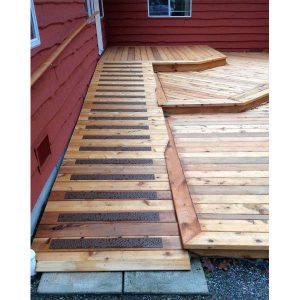
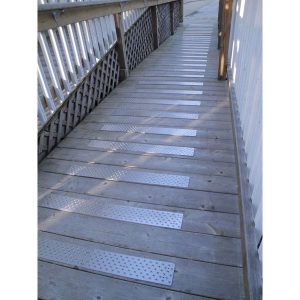
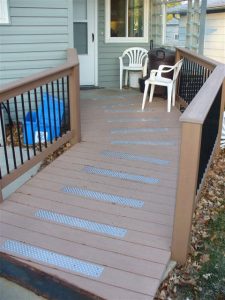
Total Score: B+
Effectiveness: A
Installation & Maintenance: A
Durability: A
Initial Price: C
Long-Term Value: A
Non-Slip Grit Tape: D-
For the most part, grit tape that you can buy at Home Depot or Amazon is not appropriate for outdoor use. There is no tape-based adhesive that can realistically stand up to rain, snow and the inevitable heat and thaw cycles.
In a limited number of outdoor wooden ramp situations, non-slip grip tape can be a short-term solution to reduce slips and falls. Rain and frost are easily dealt with by grit embedded into the tape. However, once it snows the trouble really begins. You simply can’t use a snow shovel on grit tape. Not only will you pull the tape right off the stairs if you catch an edge, but even a plastic blade will quickly defeat the thin coating protecting the aggregate.
The proper installation of non-slip grip tape does require a bit of effort as detailed here. First, it’s important that the wood surface, whether stained or painted, is clean, dry and in good shape. Heavily grained, uneven or splintering wood makes it difficult for the tape adhesive to completely bond and the effective life of grip tape is directly related to how carefully and completely it has been adhered to the steps.
There’s no maintenance that can or should be done to the tape other than to be very careful of the edges and corners, which can be easily pulled up. Once a corner or edge begins to peel, the grip tape will quickly deteriorate.
If you’re comfortable with a lifespan on outdoor wood of six months to a year, grit tape can be an inexpensive temporary solution.

Total Score: D-
Effectiveness: D
Installation & Maintenance: C
Durability: F
Initial Price: A
Long-Term Value: F
Grit Paint: B+
As long as you’re looking for function over beauty, a high quality (NOT Big Box Store) grit paint can improve the safety of a long, wooden outdoor ramp. It’s critical that you choose a top-notch grit paint like the Slip Doctor’s Dura Grip and Tuff Grip traction paints, that they are applied well, and that the paint is maintained properly. Like grit tape, non-slip paints include an aggregate that creates traction. The best anti-slip paints contain aluminum oxide or carborundum that are encapsulated in the paint, creating a rough, slip-resistant surface. We rate the effectiveness of grip paint very high for wet weather and frost, but it’s ineffectual with snow deeper than an inch.
Longevity is another challenge with anti-slip paint when used on a wood ramp. The incline of the ramp creates much more pressure between shoes and, more often than not, the wheels of wheelchairs, hand trucks and dollies. This increased pressure leads to a shorter life and the need to repaint the ramp after two to three years.
There is no maintenance that can be performed on anti-slip paints other than regular sweeping.
However, if you live where it snows you need to be very careful not to aggressively shovel a ramp painted with grit paint. While the epoxy or enamel coating is durable under normal foot traffic, it’s no match for an aluminum snow shovel. Once you start to scrape way the paint layer covering the aggregate, the system will quickly degrade.
The cost of a high-quality grit paint can run between $120 and $160 a gallon. In addition, you’ve got the consumable cost of paint brushes or rollers, trays, sandpaper, masking tape, and drop cloths that will likely cost an additional $40.
However, the longer the ramp, the more efficient the application of grit paint which reduces its initial cost while enhancing the paint’s long-term value.


